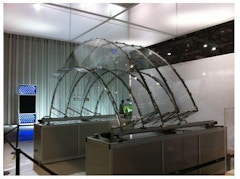
145 results
-
 In order to reduce energy consumption throughout the whole life-cycle of buildings and increase the comfort performance of building sectors, an…
In order to reduce energy consumption throughout the whole life-cycle of buildings and increase the comfort performance of building sectors, an… -

Integrated Energy Analysis
- Paper by Greg Verabian, Saurabh Shrestha, Laure Michelon,
Energy codes across the country are progressively getting stricter and increasing the threshold for a baseline building’s energy performance.… -

Form as Energy
- Paper by Matthew Fineout,
All too often, high-performance building envelopes are considered in terms of new materials and technologies that push specific systems to improve… -

Active and Energy Autonomous Window
- Paper by Annalisa Andaloro, Leire Minguez Hilera, Stefano Avesani,
Reducing GHG emissions related to energy use in buildings is a prominent obligation given their impact in terms of climate change. In this light,… -
Design and Energy Analysis
- Paper by Mahsa Farid Mohajer, Ajla Aksamija, Professor
Integration and interoperability between Building Information Modeling (BIM) and Building Energy Modeling (BEM) tools pose major challenges for the… -

The Facade and Energy Codes
- Paper by Elliot Glassman
Ever-increasing performance requirements in the latest version of the energy codes are compelling project teams to consider the thermal performance
-

Balancing Visual Comfort and Energy Efficiency
- Paper by Berardo Matalucci PhD, Director, Environmental Design Edward Palka AIA LEED AP BD+C, Designer Jennifer Siqueira LEED AP, Associate Jenny Lin, Associate Coles Jennings PE, BEMP, LEED AP BD+C, Sr. Energy and Sustainability Engineer Alex Chapin, Energy Engineer II Sameer Kumar AIA, Director, Enclosure Design Nadine Bergen AIA LEED AP, Project Director Christopher Sharples AIA, Principal
With increasing interest in wellness and human-centric design in workplaces, the design of building enclosures is predicated on optimizing competing… -

Impact Of Thermal Bridges On The Energy Response Of A Building
- Paper by Ilaria Sebastiani · Riccardo Pinotti · Stefano Avesani · Simone D’Amore · Stefano Pampanin
The European building stock is mainly constituted by highly energy demanding buildings. The only way to a more sustainable and decarbonized building
-

Effect of Thermal Bridging on Buildings' Energy Performance
- Paper by Mahsa Farid Mohajer · Ajla Aksamija
Heat transfer through building facades can occur by any combinations of conduction, convection, and/or radiation. Conductive heat transfer depends on
-

Novel Active Facade Systems and Their Energy Performance in Commercial Buildings
- Paper by Ajla Aksamija, Professor and Chair Mahsa Farid Mohajer, PhD Candidate Zlatan Aksamija, Associate Professor
This article presents results of a research study that focuses on understanding energy performance of novel facade systems that integrate… -
Data-Driven Shading Systems
- Paper by Simon Schleicher · Luis Santos · Luisa Caldas
Analyzing the energy performance of complex building envelopes, determining the need for sun protection, and assessing the effectiveness of shading
-

European Facade Networks
- Paper by Ulrich Knaack · Uta Pottgiesser · Tillmann Klein · Andreas Luible · Siebe Bakker
The European climate and energy targets for 2020 demand significant improvement of the energy performance of buildings since one third of the
-
Daylighting Post-Occupancy Evaluation Study
- Paper by Jae Yong Suk, Ph.D. · Helena Zambrano, AIA
Daylighting is a key strategy to energy efficiency and improved occupant comfort, health, and productivity in buildings. However, providing desired
-
Attention to Overheating in Curtainwall Buildings
- Paper by Yuzhen Zhou NFRC CS, LEED AP, Technical Director at Warmframe Technology
Several years ago, Technoform and the Solar Energy Research Institute of Singapore (SERIS) researched the thermal performance of different aluminum… -

Parametric Facade Design
- Paper by Patricia E. Camporeale, María del Pilar Mercader Moyano,
Parametric Design has become an invaluable tool for complex tasks like designing energy efficient buildings when joined to performance-based… -
Daylighting Parametric Workflows Used for Adaptive Reuse
- Paper by Alfonso E. Hernandez, AIA, NCARB, LEED BD+C
Daylighting & Solar Glare control, which affect both the energy consumption of the building as well as the comfort of the occupants, become
-

Pioneering the Structural Terracotta Mullion Façade
- Paper by Victoria Ereskina, Façade Design Professional John Neary, Sr. Façade Specialist
Architects today must explore alternative enclosure materials to meet evolving energy codes and embodied carbon regulations. Terra cotta has been… -

Kinetic Solar Envelope
- Paper by Christina Koukelli, Facade Engineer Alejandro Prieto, Researcher Serdar Asut, Academic, Architect
Kinetic responsive systems are gaining attention in architectural applications, to reduce the building’s energy consumption and environmental impact,… -
Let Thin Glass in the Facade Move
- Paper by Prof. DI Dr. Jürgen Neugebauer · DI Dr. Markus Wallner-Novak
Facades play an important role in the control of energy flow and energy consumption in buildings as they represent the interface between the outdoor
-

Thermal Bridging and Building Facades
- Paper by Ivan Lee
Thermal bridging through building façades have been overlooked by designers and building energy codes and standards in the past, which has led to



